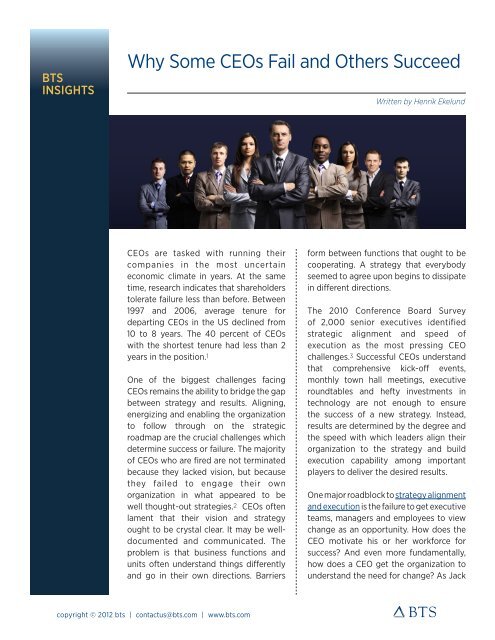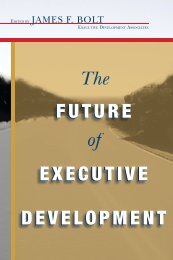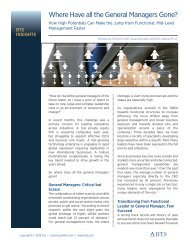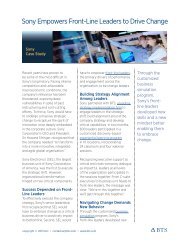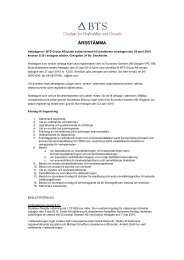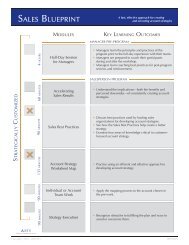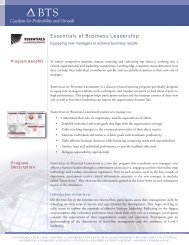Why Some CEOs Fail and Others Succeed - BTS
Why Some CEOs Fail and Others Succeed - BTS
Why Some CEOs Fail and Others Succeed - BTS
You also want an ePaper? Increase the reach of your titles
YUMPU automatically turns print PDFs into web optimized ePapers that Google loves.
<strong>BTS</strong><br />
INSIGHTS<br />
<strong>Why</strong> <strong>Some</strong> <strong>CEOs</strong> <strong>Fail</strong> <strong>and</strong> <strong>Others</strong> <strong>Succeed</strong><br />
Written by Henrik Ekelund<br />
<strong>CEOs</strong> are tasked with running their<br />
companies in the most uncertain<br />
economic climate in years. At the same<br />
time, research indicates that shareholders<br />
tolerate failure less than before. Between<br />
1997 <strong>and</strong> 2006, average tenure for<br />
departing <strong>CEOs</strong> in the US declined from<br />
10 to 8 years. The 40 percent of <strong>CEOs</strong><br />
with the shortest tenure had less than 2<br />
years in the position. 1<br />
One of the biggest challenges facing<br />
<strong>CEOs</strong> remains the ability to bridge the gap<br />
between strategy <strong>and</strong> results. Aligning,<br />
energizing <strong>and</strong> enabling the organization<br />
to follow through on the strategic<br />
roadmap are the crucial challenges which<br />
determine success or failure. The majority<br />
of <strong>CEOs</strong> who are fired are not terminated<br />
because they lacked vision, but because<br />
they failed to engage their own<br />
organization in what appeared to be<br />
well thought-out strategies. 2 <strong>CEOs</strong> often<br />
lament that their vision <strong>and</strong> strategy<br />
ought to be crystal clear. It may be welldocumented<br />
<strong>and</strong> communicated. The<br />
problem is that business functions <strong>and</strong><br />
units often underst<strong>and</strong> things differently<br />
<strong>and</strong> go in their own directions. Barriers<br />
form between functions that ought to be<br />
cooperating. A strategy that everybody<br />
seemed to agree upon begins to dissipate<br />
in different directions.<br />
The 2010 Conference Board Survey<br />
of 2,000 senior executives identified<br />
strategic alignment <strong>and</strong> speed of<br />
execution as the most pressing CEO<br />
challenges. 3 Successful <strong>CEOs</strong> underst<strong>and</strong><br />
that comprehensive kick-off events,<br />
monthly town hall meetings, executive<br />
roundtables <strong>and</strong> hefty investments in<br />
technology are not enough to ensure<br />
the success of a new strategy. Instead,<br />
results are determined by the degree <strong>and</strong><br />
the speed with which leaders align their<br />
organization to the strategy <strong>and</strong> build<br />
execution capability among important<br />
players to deliver the desired results.<br />
One major roadblock to strategy alignment<br />
<strong>and</strong> execution is the failure to get executive<br />
teams, managers <strong>and</strong> employees to view<br />
change as an opportunity. How does the<br />
CEO motivate his or her workforce for<br />
success And even more fundamentally,<br />
how does a CEO get the organization to<br />
underst<strong>and</strong> the need for change As Jack<br />
copyright © 2012 bts | contactus@bts.com | www.bts.com
<strong>BTS</strong><br />
INSIGHTS<br />
<strong>Why</strong> <strong>Some</strong> <strong>CEOs</strong> <strong>Fail</strong> <strong>and</strong> <strong>Others</strong> <strong>Succeed</strong><br />
Welch said, ‘Getting every employee’s<br />
mind into the game is a huge part of what<br />
the CEO job is all about…There’s nothing<br />
more important.” 4<br />
Successful leaders underst<strong>and</strong> <strong>and</strong><br />
appreciate that force-feeding views<br />
to employees who have been hired to<br />
think for themselves is not the solution.<br />
What works better is to let valuable<br />
employees discover the advantages of<br />
new approaches on their own terms, let<br />
them take ownership for their roles <strong>and</strong><br />
develop action plans that reflect their<br />
positions <strong>and</strong> specialized expertise in<br />
the strategy execution. This approach<br />
is likely to result in a motivational <strong>and</strong><br />
inspirational atmosphere <strong>and</strong> a “can-do”<br />
culture that remains true to core beliefs<br />
while continually adapting <strong>and</strong> changing.<br />
Sodexo Invents a New Business<br />
Sodexo is a €14.7 billion on-site services<br />
<strong>and</strong> employee motivation solutions<br />
company with more than 380,000<br />
employees serving 50 million people daily.<br />
When Michel L<strong>and</strong>el took over as CEO in<br />
September 2005, Sodexo was still known<br />
primarily for food services, despite its<br />
position as the third largest outsourcing<br />
company in the world, <strong>and</strong> outst<strong>and</strong>ing<br />
expertise in services like high-end medical<br />
equipment maintenance, defense, senior<br />
care <strong>and</strong> education. L<strong>and</strong>el introduced a<br />
strategy to better reflect current dem<strong>and</strong><br />
from Sodexo customers <strong>and</strong> capture<br />
growing market opportunities. The CEO<br />
quickly engaged the top Sodexo leaders<br />
to the strategy—which would push them<br />
to exp<strong>and</strong> beyond their comfort zone in<br />
food services—to become a valued<br />
service provider for all non-core client<br />
services.<br />
In March 2009, the Sodexo Management<br />
Institute was tasked with engaging 940<br />
Sodexo managers <strong>and</strong> vice presidents<br />
around the world with the new strategy.<br />
They launched the CLIMB (Change,<br />
Leadership, Implementation, Behaviors)<br />
program. CLIMB incorporates connected<br />
on-line learning, face-to-face sessions,<br />
<strong>and</strong> a customized, competitive simulation<br />
developed with <strong>BTS</strong>. The goal: get 940<br />
managers, of different geographies,<br />
genders, generations <strong>and</strong> lines of<br />
business, living <strong>and</strong> breathing the<br />
new strategy. The change expected<br />
was dramatic; L<strong>and</strong>el announced, “We<br />
are inventing a new business.” CLIMB<br />
participants are organized into large<br />
groups of 100 who complete a four-month<br />
course of e-learning <strong>and</strong> preparation. They<br />
then are ready to participate in the heart<br />
of the program, VirtuoSo, a virtual, threeday<br />
onsite simulation. VirtuoSo simulates<br />
the three-year lifecycle of an enterprise<br />
modeled on Sodexo for which the teams<br />
serve as chief executives. Teams develop<br />
business plans <strong>and</strong> choose to invest in a<br />
series of strategic initiatives, all the while<br />
mindful of profitability, cash, customer<br />
satisfaction, <strong>and</strong> employee retention.<br />
The teams get a realistic opportunity to<br />
practice the new Sodexo strategy.<br />
The evaluations from the CLIMB<br />
program are back <strong>and</strong> managers are<br />
convinced of its effectiveness while<br />
employees are hooked. “The critical<br />
elements of the solution, the VirtuoSo<br />
simulation, were the safe environment to<br />
copyright © 2012 bts | contactus@bts.com | www.bts.com
<strong>BTS</strong><br />
INSIGHTS<br />
<strong>Why</strong> <strong>Some</strong> <strong>CEOs</strong> <strong>Fail</strong> <strong>and</strong> <strong>Others</strong> <strong>Succeed</strong><br />
take risks with business decision making,<br />
the ability for participants to see decisions<br />
in real time, <strong>and</strong> an extremely competitive<br />
environment that really got our people<br />
involved <strong>and</strong> committed,” said Elisabeth<br />
Carpentier, vice president of human<br />
resources at Sodexo.<br />
<strong>CEOs</strong> like L<strong>and</strong>el are increasingly turning<br />
to business simulations to develop the<br />
mindset <strong>and</strong> capabilities their companies<br />
require to accelerate change <strong>and</strong><br />
realize business results. Sophisticated<br />
business simulations focus on learning<br />
by experience <strong>and</strong> are customized to<br />
model the challenges, tradeoffs, <strong>and</strong><br />
market environments of the company<br />
itself. In these simulations, participants<br />
play a critical role in the decision making<br />
process of the company. Participants<br />
must make decisions in the framework<br />
of the initiatives they are involved with,<br />
in the context of real-world business<br />
<strong>and</strong> financial dynamics. The best<br />
simulations provide participants with<br />
access to decision tools, resources, <strong>and</strong><br />
collaboration opportunities that directly<br />
mirror the real world.<br />
Making it happen:<br />
The world’s largest provider of<br />
virtualization software, VMware has grown<br />
rapidly by moving beyond basic hardware<br />
consolidation along with dramatic<br />
advances in the efficiency, availability <strong>and</strong><br />
manageability of IT resources.<br />
In 2009, VMware embarked on a new<br />
phase of growth that would build upon its<br />
success to lead the industry through the<br />
anticipated IT industry transformation.<br />
The goal: a broader strategy for helping<br />
customers transform IT to achieve a more<br />
business-centric approach.<br />
VMware chief operating officer <strong>and</strong> office<br />
of the president executive Tod Nielsen<br />
needed to rapidly align the management<br />
team to the company’s vision <strong>and</strong> drive<br />
home the game-changing industry<br />
forces at work. Those forces included<br />
the emergence of new alternatives for<br />
supplying IT needs (i.e. cloud computing),<br />
increased competition, consolidation,<br />
<strong>and</strong> CIOs having to do more with less.<br />
The executive team wanted to build<br />
management confidence <strong>and</strong> expertise to<br />
deliver on the new strategy.<br />
Nielsen worked closely with <strong>BTS</strong> on a<br />
customized simulation that provided<br />
a high impact, experiential program<br />
for building alignment <strong>and</strong> execution<br />
capability. The simulation experience<br />
realistically modeled the shifts in the IT<br />
industry, integrated VMware’s strategic<br />
initiatives, <strong>and</strong> anticipated future business<br />
challenges.<br />
The result A two-day meeting, featuring<br />
a simulation, compelled 500 company<br />
leaders with very different perspectives<br />
to collaborate in new ways, work<br />
together, <strong>and</strong> underst<strong>and</strong> the real tradeoffs—as<br />
well as the real friction points—<br />
inherent in VMware’s strategy. Through<br />
working together <strong>and</strong> living the roles<br />
<strong>and</strong> responsibilities of their colleagues<br />
from different organizations, senior<br />
leaders became more deeply aligned with<br />
copyright © 2012 bts | contactus@bts.com | www.bts.com
<strong>BTS</strong><br />
INSIGHTS<br />
<strong>Why</strong> <strong>Some</strong> <strong>CEOs</strong> <strong>Fail</strong> <strong>and</strong> <strong>Others</strong> <strong>Succeed</strong><br />
the strategy, took a greater ownership<br />
stake, accelerated on-the-job action, <strong>and</strong><br />
ultimately allowed VMware to kick off the<br />
year with positive momentum.<br />
“The <strong>BTS</strong> custom business simulation<br />
accurately modeled our business<br />
challenges <strong>and</strong> anticipated our future<br />
evolution,” said VMware co-president,<br />
Application Platform, Tod Nielsen. “The<br />
experience allowed our top 500 leaders<br />
to not just see the new strategy but to<br />
practice making our strategy <strong>and</strong> vision<br />
a reality. The two day simulation got<br />
leaders from different organizations with<br />
disparate points of view to work together<br />
<strong>and</strong> underst<strong>and</strong> the real trade-offs <strong>and</strong><br />
friction points inherent in our strategy.<br />
The simulation experience provided the<br />
‘big picture’ view we needed.”<br />
Business Simulations: Practice<br />
Makes Perfect<br />
<strong>CEOs</strong> are realizing that innovative tools<br />
<strong>and</strong> processes are available to help<br />
companies communicate <strong>and</strong> build<br />
commitment for complex multi-year<br />
business strategies. Through simulations<br />
<strong>and</strong> experiential learning tools, division<br />
leaders, directors, <strong>and</strong> frontline managers<br />
can step outside of their comfort level in<br />
a safe environment <strong>and</strong> model decision<br />
making while managing risk. This practice<br />
opportunity allows participants to leave<br />
the exercise with confidence <strong>and</strong> a deep<br />
sense of ownership of the change. Equally<br />
significantly, these programs provide the<br />
platform for a CEO to communicate his or<br />
her vision in a way that allows the entire<br />
executive team to live, breathe <strong>and</strong> lead<br />
the new strategy in the organization.<br />
By using business simulations, <strong>CEOs</strong><br />
avoid the type of top-down strategy<br />
communications that are likely to fall<br />
prey to managerial misinterpretation, <strong>and</strong><br />
achieve instead the motivational force<br />
<strong>and</strong> alignment that are needed to deliver<br />
business success. Business simulations<br />
provide rapid organizational alignment,<br />
build vital confidence in the strategy’s<br />
success, <strong>and</strong> ultimately help <strong>CEOs</strong> deliver<br />
better results faster.<br />
1 Chris Zook <strong>and</strong> James Allen, “Profit from the Core:<br />
A Return to Growth in Turbulent Time,” Harvard<br />
Business Review Press, February 2010.<br />
2 Ram Charan <strong>and</strong> Geoffrey Colvin, “<strong>Why</strong> <strong>CEOs</strong> <strong>Fail</strong>,”<br />
Fortune, 21 June 2010.<br />
3 Linda Barrington,’CEO Challenge 2010, Top 10<br />
Challenges,” The Conference Board, February 2010.<br />
4 Jack Welch with John A. Byrne, Jack: Straight from<br />
the Gut (Warner Books, 2001)<br />
________________________________<br />
<strong>BTS</strong> is a leading global strategy implementation<br />
consultancy dedicated to building alignment,<br />
mindset <strong>and</strong> capabilities that improve business<br />
results for our clients. Founded in 1986 <strong>and</strong><br />
serving over 400 clients worldwide, <strong>BTS</strong> is a<br />
publically traded company with more than 25<br />
offices in 18 countries.<br />
About the author-<br />
Henrik Ekelund is<br />
the founder <strong>and</strong> CEO<br />
of <strong>BTS</strong>.<br />
copyright © 2012 bts | contactus@bts.com | www.bts.com


